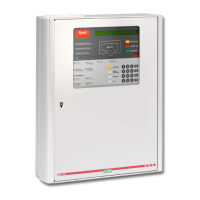Panasonic Eco Solutions Nordic AB
MEW01622 Rev: - EBL128 Planning Instructions V2.0.x
118
14 Special New Zealand functions
NOTE! The functions in this chapter are valid for the New Zealand
convention only.
14.1 Alarm devices
14.1.1 Silence alarm devices (inside switch)
On the c.i.e. front, the button "Silence alarm devices" (see Operating
Instructions, button "P3") is called the "inside switch" and toggles
between two states:
Alarm devices disabled
All programmable outputs of type "Alarm devices" are
disabled, i.e. they cannot be activated.
Alarm devices not disabled
All programmable outputs of type "Alarm devices" enabled,
i.e. they can be activated.
If the inside switch is in its disabled state when the c.i.e. door is being
closed the buzzer will beep once and the message "Silence switch
left active" will be shown in the LCD. This message has lower
priority than fire alarms but higher than other disablements and faults.
NOTE! The inside switch has no function if the outside switch (see
below) is activated (ON).
14.1.2 New Zealand FB Silence switch (outside switch)
The "New Zealand FB Silence switch" is called the "outside switch"
since it is placed outside the c.i.e. The outside switch is a key switch
and connected to a programmable input with the trigger condition
"New Zealand FB Silence switch".
The outside switch is turned ON (i.e. from not activated to activated
state).
All programmable outputs of type "Alarm devices" are
disabled
, i.e. they cannot be activated. The "inside switch"
(se above) has no function.
LED:s "Fire" (on the front) changes from blinking to steady
(continuous).
The c.i.e. built-in buzzer is disabled.
A fault is generated
: "FAULT: FB Silence switch
active".
Indicated by LED "Disablements".
This is valid also if the fire alarm is activated after the outside switch is
turned ON.
Always latched, regardless of if faults are programmed to be not latched.

